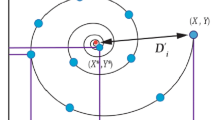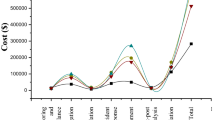Abstract
Internet of Things (IoT) played a significant role in Healthcare. One of the major challenges in IoT health is security. For this reason, regarding the past studies, there is a lack of a comprehensive security framework that encompasses all layers of IoT. This article offers a security framework with four layers of sensor, network, service, and application. These layers help to develop security mechanisms within the proposed framework by providing security solutions. Also, security improvement has been influenced by the Multi Criteria Decision Making (MCDM) technique. To evaluate this framework, a conceptual model was defined with six critical criteria including security, network, services, interoperability, privacy, and reliability. The validity and reliability of this conceptual model were analyzed using SPSS 24 and AMOS 18. After proving the important criteria in the proposed model, we used the MCDM process of fuzzy analytic network process to prioritize the important criteria. The evaluation results of the conceptual model in the proposed framework, after analyzing the routes, show the validity of the proposed criteria. Therefore, in this model, 8 out of 12 communication routes between the criteria have a positive and significant relationship and 4 routes do not. The results of prioritizing important criteria in the research model, using analytic network process method, show that the network criterion, and authentication and validation sub-criteria have the highest priority among the proposed criteria. Thus, it can be decided that security solutions in the network layer and authentication and validation sub-criteria help to develop the proposed security framework.













Similar content being viewed by others

Explore related subjects
Discover the latest articles and news from researchers in related subjects, suggested using machine learning.References
Abdel-Basset M, Manogaran G, Mohamed M (2018) Internet of things (iot) and its impact on supply chain: a framework for building smart, secure and efficient systems. Future Gener Comput Syst 86:614–628
AbdulGhaffar A, Mostafa SM, Alsaleh A, Sheltami T, Shakshuki EM (2019) Internet of things based multiple disease monitoring and health improvement system. J Ambient Intell Hum Comput 11:1–9
Akbarzadeh A, Bayat M, Zahednejad B, Payandeh A, Aref MR (2019) A lightweight hierarchical authentication scheme for internet of things. J Ambient Intell Hum Comput 10(7):2607–2619
Alaba FA, Othman M, Hashem IAT, Alotaibi F (2017) Internet of things security: a survey. J Netw Comput Appl 88:10–28
Alamr AA, Kausar F, Kim J, Seo C (2018) A secure ecc-based rfid mutual authentication protocol for internet of things. J Super Comput 74(9):4281–4294
Alioto M (2017) Enabling the Internet of Things: from integrated circuits to integrated systems. Springer International Publishing AG, Switzerland
Alshehri MD, Hussain FK (2019) A fuzzy security protocol for trust management in the internet of things (fuzzy-iot). Computing 101(7):791–818
Ammar M, Russello G, Crispo B (2018) Internet of things: a survey on the security of iot frameworks. J Inf Secur Appl 38:8–27
Aziz A, Singh K (2019) Lightweight security scheme for internet of things. Wirl Pers Commun 104(2):577–593
Bernabe JB, Ramos JLH, Gomez AFS (2016) Taciot: multidimensional trust-aware access control system for the internet of things. Soft Comput 20(5):1763–1779
Buckley JJ (1985) Fuzzy hierarchical analysis. Fuzzy Sets Syst 17(3):233–247
Chen Y, Jin Q, Fang H, Lei H, Hu J, Wu Y, Chen J, Wang C, Wan Y (2019) Analytic network process: academic insights and perspectives analysis. J Clean Prod 235:1276–1294
Čolaković A, Hadžialić M (2018) Internet of things (iot): a review of enabling technologies, challenges, and open research issues. Comput Netw 144:17–39
Dabbagh M, Rayes A (2019) Internet of things security and privacy. In: Internet of Things from hype to reality. Springer, pp 211–238
Deif D, Gadallah Y (2017) A comprehensive wireless sensor network reliability metric for critical internet of things applications. EURASIP J Wirl Commun Netw 2017(1):145
da Silva FJF, e Sá JO (2016) Internet-of-things: strategic research agenda evolution. In: 2016 11th Iberian Conference on Information Systems and Technologies (CISTI), 2016 11th Iberian Conference on Information Systems and Technologies (CISTI), pp 1–4
Eswaran SP, Sripurushottama S, Jain M (2018) Multi criteria decision making (mcdm) based spectrum moderator for fog-assisted internet of things. Proc Comput Sci 134:399–406
Fu C, Chang W, Liu W, Yang S (2020) Data-driven selection of multi-criteria decision-making methods and its application to diagnosis of thyroid nodules. Comput Ind Eng 145:106490
Gondalia A, Dixit D, Parashar S, Raghava V, Sengupta A, Sarobin VR (2018) Iot-based healthcare monitoring system for war soldiers using machine learning. Proc Comput Sci 133:1005–1013
Govindan K, Shankar KM, Kannan D (2016) Application of fuzzy analytic network process for barrier evaluation in automotive parts remanufacturing towards cleaner production-a study in an indian scenario. J Clean Prod 114:199–213
Guo J, Chen R, Tsai JJ (2017) A survey of trust computation models for service management in internet of things systems. Comput Commun 97:1–14
Gyrard A, Serrano M, Atemezing GA (2015) Semantic web methodologies, best practices and ontology engineering applied to internet of things. In: 2015 IEEE 2nd World Forum on Internet of Things (WF-IoT), IEEE, pp 412–417
Hair JF, Black WC, Babin BJ, Anderson RE, Tatham RL, et al (2006) Multivariate data analysis, vol 6, pp 671–850
Hou J, Qu L, Shi W (2019) A survey on internet of things security from data perspectives. Comput Netw 148:295–306
Kaur P, Kumar R, Kumar M (2019) A healthcare monitoring system using random forest and internet of things (iot). Multimed Tools Appl 78:1–12
Kumar PM, Lokesh S, Varatharajan R, Babu GC, Parthasarathy P (2018) Cloud and iot based disease prediction and diagnosis system for healthcare using fuzzy neural classifier. Future Gener Comput Syst 86:527–534
Li N, Sun M, Bi Z, Su Z, Wang C (2014) A new methodology to support group decision-making for iot-based emergency response systems. Inf Syst Front 16(5):953–977
Li S, Da Xu L, Zhao S (2015) The internet of things: a survey. Inf Syst Front 17(2):243–259
Li Y, Sun Z, Han L, Mei N (2017) Fuzzy comprehensive evaluation method for energy management systems based on an internet of things. IEEE Access 5:21312–21322
Manogaran G, Chilamkurti N, Hsu CH (2018) Emerging trends, issues, and challenges in internet of medical things and wireless networks. Pers Ubiquitous Comput 22(5–6):879–882
Mehta R, Sahni J, Khanna K (2018) Internet of things: vision, applications and challenges. Proc Comput Sci 132:1263–1269
Mendoza CVL, Kleinschmidt JH (2018) A distributed trust management mechanism for the internet of things using a multi-service approach. Wirl Pers Commun 103(3):2501–2513
Mohammadzadeh AK, Ghafoori S, Mohammadian A, Mohammadkazemi R, Mahbanooei B, Ghasemi R (2018) A fuzzy analytic network process (fanp) approach for prioritizing internet of things challenges in iran. Technol Soc 53:124–134
Morente-Molinera J, Wu X, Morfeq A, Al-Hmouz R, Herrera-Viedma E (2020) A novel multi-criteria group decision-making method for heterogeneous and dynamic contexts using multi-granular fuzzy linguistic modelling and consensus measures. Inf Fusion 53:240–250
Mukhopadhyay SC, Suryadevara NK (2014) Internet of things: Challenges and opportunities. In: Internet of Things, Springer, pp 1–17
Nabeeh NA, Abdel-Basset M, El-Ghareeb HA, Aboelfetouh A (2019) Neutrosophic multi-criteria decision making approach for iot-based enterprises. IEEE Access 7:59559–59574
Nilashi M, Ahmadi H, Ahani A, Ravangard R, bin Ibrahim O (2016) Determining the importance of hospital information system adoption factors using fuzzy analytic network process (anp). Technol Forecast Soc Change 111:244–264
Ossadnik W, Schinke S, Kaspar RH (2016) Group aggregation techniques for analytic hierarchy process and analytic network process: a comparative analysis. Group Decis Negot 25(2):421–457
Pal S, Hitchens M, Varadharajan V, Rabehaja T (2019) Policy-based access control for constrained healthcare resources in the context of the internet of things. J Netw Comput Appl 139:57–74
Patel KK, Patel SM et al (2016) Internet of things-iot: definition, characteristics, architecture, enabling technologies, application & future challenges. Int J Eng Sci Comput 6(5):6122–6131
Perumal K, Manohar M (2017) A survey on internet of things: Case studies, applications, and future directions. In: Internet of Things: novel advances and envisioned applications. Springer, pp 281–297
Prevett TT, Anderson BE (2017) Using an analytic network process model to incorporate qualitative factors into multi-criteria global modal choice decisions. J Transp Manag 27(2):3
Ren X, Li W, Ding S, Dong L (2020) Sustainability assessment and decision making of hydrogen production technologies: a novel two-stage multi-criteria decision making method. Int J Hydrogen Energy. https://doi.org/10.1016/j.ijhydene.2019.12.134
Rizwan P, Rajasekhara Babu M, Suresh K (2017) Design and development of low investment smart hospital using internet of things through innovative approaches. Biomed Res 28(11):4979–4985
Saaty TL (1999) Fundamentals of the analytic network process. In: Proceedings of the 5th international symposium on the analytic hierarchy process, pp 12–14
Sarkar S (2016) Internet of things–robustness and reliability. In: Internet of Things. Elsevier, pp 201–218
Serpanos D, Wolf M (2017) Internet-of-things (IoT) systems: architectures, algorithms, methodologies. Springer International Publishing AG, Switzerland
Shin DH (2010) The effects of trust, security and privacy in social networking: A security-based approach to understand the pattern of adoption. Interact Comput 22(5):428–438
Shin DH (2017) Conceptualizing and measuring quality of experience of the internet of things: exploring how quality is perceived by users. Inf Manag 54(8):998–1011
Shin D (2019) A living lab as socio-technical ecosystem: evaluating the korean living lab of internet of things. Gov Inf Q 36(2):264–275
Sicari S, Rizzardi A, Grieco LA, Coen-Porisini A (2015) Security, privacy and trust in internet of things: the road ahead. Comput Netw 76:146–164
Tanganelli G, Curado M (2019) Reliability of internet of things: smart objects and services. J Reliable Intell Environ 5(1):1–1
Teixeira FA, Pereira FM, Wong HC, Nogueira JM, Oliveira LB (2019) Siot: securing internet of things through distributed systems analysis. Future Gener Comput Syst 92:1172–1186
Verma R, Maheshwari S (2017) A new measure of divergence with its application to multi-criteria decision making under fuzzy environment. Neural Comput Appl 28(8):2335–2350
Wang F, Ge B, Zhang L, Chen Y, Xin Y, Li X (2013) A system framework of security management in enterprise systems. Syst Res Behav Sci 30(3):287–299
Wang Y, Chen C, Jiang Q (2018) Security algorithm of internet of things based on zigbee protocol. Cluster Comput 22:1–8
Whitmore A, Agarwal A, Da Xu L (2015) The internet of things-a survey of topics and trends. Inf Syst Front 17(2):261–274
Wu T, Wu F, Redouté JM, Yuce MR (2017) An autonomous wireless body area network implementation towards iot connected healthcare applications. Ieee Access 5:11413–11422
Yang Z, Zhu J (2019) Online product purchasing decision through iot platform: based on normal stochastic multi-criteria decision method and vertical projection distance. Cluster Comput 22(4):8161–8169
Zamanifar A, Nazemi E (2019) An approach for predicting health status in iot health care. J Netw Comput Appl 134:100–113
Zha S, Guo Y, Huang S, Wang S (2020) A hybrid mcdm method using combination weight for the selection of facility layout in the manufacturing system: a case study. Math Probl Eng
Zhang Q, Xu D (2018) Security authentication technology based on dynamic bayesian network in internet of things. J Ambient Intell Hum Comput 11:1–8
Zhang W, Yang J, Su H, Kumar M, Mao Y (2018) Medical data fusion algorithm based on internet of things. Pers Ubiquit Comput 22(5–6):895–902
Author information
Authors and Affiliations
Corresponding author
Additional information
Publisher's Note
Springer Nature remains neutral with regard to jurisdictional claims in published maps and institutional affiliations.
Rights and permissions
About this article
Cite this article
Haghparast, M.B., Berehlia, S., Akbari, M. et al. Developing and evaluating a proposed health security framework in IoT using fuzzy analytic network process method. J Ambient Intell Human Comput 12, 3121–3138 (2021). https://doi.org/10.1007/s12652-020-02472-3
Received:
Accepted:
Published:
Issue Date:
DOI: https://doi.org/10.1007/s12652-020-02472-3



